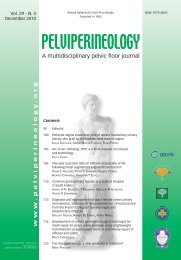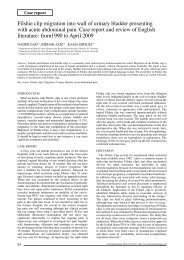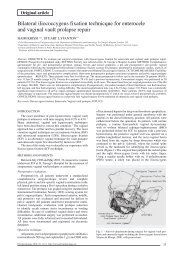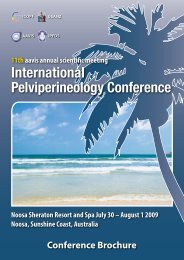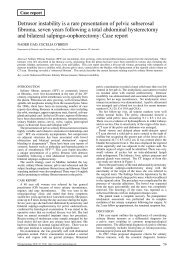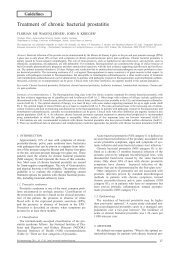Interstitial cystitis (painful bladder syndrome) may ... - ResearchGate
Interstitial cystitis (painful bladder syndrome) may ... - ResearchGate
Interstitial cystitis (painful bladder syndrome) may ... - ResearchGate
You also want an ePaper? Increase the reach of your titles
YUMPU automatically turns print PDFs into web optimized ePapers that Google loves.
<strong>Interstitial</strong> <strong>cystitis</strong> (<strong>painful</strong> <strong>bladder</strong> <strong>syndrome</strong>)<br />
vaginal fornix tenderness found pre-intervention all<br />
decreased to zero on a VAS scale.<br />
DISCUSSION<br />
The amelioration of vulvodynia, lower abdominal pain,<br />
urethral tenderness, and cervical excitation pain following<br />
injection of local anaesthetic into the position of the<br />
uterosacral ligaments was emphatic. All 3 patients also<br />
had posterior fornix symptoms (fig. 1) nocturia, urgency,<br />
abnormal <strong>bladder</strong> emptying. The association of these<br />
posterior fornix symptoms with <strong>painful</strong> <strong>bladder</strong> <strong>syndrome</strong><br />
(<strong>Interstitial</strong> Cystitis) in these patients and those from other<br />
studies 7,8 support (but do not finally prove) the hypothesis<br />
that these separate manifestations of pain <strong>may</strong> be referred<br />
pain from these ligaments.<br />
Another explanation for the disappearance of cervical,<br />
<strong>bladder</strong> and urethral tenderness, is that the nerve block<br />
injection into the uterosacral ligaments ligament blocked<br />
transmission of pain impulses from these organs.<br />
Frankenhauser’s plexus located just lateral to the uterosacral<br />
ligaments is an important pathway for pain. This explanation<br />
cannot account for the disappearance of lower abdominal<br />
pain in all 3 patients with the LA injection, nor the cure<br />
of chronic lower abdominal and cervical excitation pain<br />
following surgical tensioning of lax uterosacral ligaments, 1-4<br />
which indicate cause and effect. The hypothesis concerning<br />
<strong>bladder</strong> pain causation by lax uterosacral ligaments in this<br />
group of IC patients awaits this crucial test.<br />
Acknowledgments<br />
I acknowledge the generous assistance of Professor<br />
Mauro Cervigni and Professor Roberto Angioli provided for<br />
this study.<br />
Fig. 1 - Pictorial Diagnostic Algorithm The anterior (pubourethral)<br />
and posterior (uterosacral) ligaments are in purple. The middle<br />
ligaments (ATFP& cardinal) are not shown in this diagram. There<br />
are 3 columns, one for each ligament group and the symptoms<br />
and prolapses (lumps) associated with damage to these ligaments.<br />
Labelling is ‘front’ and ‘back’ instead of ‘anterior’ and ‘posterior’.<br />
the injection, her central pain had moved from a VAS (visual<br />
analogue scale) of 8 to 0, and her right-sided pain from a VAS<br />
of 9 to 4. Her vulval hypersensitivity, suburethral tenderness,<br />
and cervical excitation pain had all disappeared. There was<br />
only 1st degree prolapse on speculum examination, with<br />
separation of the uterosacral ligaments.<br />
Mrs AA aged 51 years, para 2, had a 10 year history<br />
of chronic <strong>bladder</strong> pain, left-sided abdominal pain, and<br />
dyspareunia. She had typical symptoms of the posterior<br />
fornix <strong>syndrome</strong>, nocturia x3-8 per night, urgency (but<br />
no incontinence) and abnormal <strong>bladder</strong> emptying. On<br />
examination she had tenderness on the left side of her lower<br />
abdomen, extreme sensitivity on palpating the urethra and<br />
the cervix. Within 5 minutes of the injection, her left sided<br />
pain had moved from a VAS) of 9 to 0. Her suburethral<br />
tenderness, and cervical excitation pain had all disappeared.<br />
On speculum examination, there was separation of the<br />
uterosacral ligaments, but no obvious uterine prolapse.<br />
Mrs ML aged 40 years, para 2, had undergone a<br />
hysterectomy 5 years earlier, and presented with left-sided<br />
pain, <strong>bladder</strong> tenderness, vulvodynia, which had worsened<br />
over the past 2 years. She also had nocturia x2 per night,<br />
hourly frequency, urgency (but no incontinence). On testing,<br />
she had hypersensitivity only on the left side of her introitus,<br />
and tenderness over the lower left side of her abdomen and<br />
vaginal fornix. Following the local anaesthetic injection,<br />
her left-sided pain decreased by an estimated 40% on a<br />
VAS scale. The suburethral tenderness, introital sensitivity,<br />
REFERENCES<br />
1. Petros PE & Ulmsten U. The posterior fornix <strong>syndrome</strong>:<br />
a multiple symptom complex of pelvic pain and abnormal<br />
urinary symptoms deriving from laxity in the posterior fornix.<br />
Scandinavian Journal of Urology and Nephrology (1993) - Vol<br />
27 Supplement No 153 - PART IV: 89-93.<br />
2. Farnsworth BN Posterior Intravaginal Slingplasty (infraccocygeal<br />
sacropexy) for severe posthysterectomy vaginal vault prolapsea<br />
preliminary report, Int J Urogynecol 2002; 13:4-8.<br />
3. Abendstein B, Brugger BA, Furtschegger A, Rieger M, Petros<br />
PE. Role of the uterosacral ligaments in the causation of rectal<br />
intussusception, abnormal bowel emptying, and fecal incontinencea<br />
prospective study, J. Pelviperineology 2008; 27:118-121.<br />
4. Petros PEP, Richardson PA, The TFS posterior sling improves<br />
overactive <strong>bladder</strong>, pelvic pain and abnormal emptying,<br />
even with minor prolapse – a prospective urodynamic study,<br />
Pelviperineology 2010, in press.<br />
5 Bornstein J, Zarfati, D, Petros PEP, Causation of vulvar<br />
vestibulitis ANZJOG 2005, 45: 538–541.<br />
6 Petros PE, <strong>Interstitial</strong> Cystitis, CHAPTER 7 – Current and<br />
Emerging Res earch Issues, The Female Pelvic Floor 2 nd Edition,<br />
Petros PE, 2006, Springer Heidelberg, p 209.<br />
7 Butrick CW, Sanford D, Hou Q, Mahnken JD. Chronic<br />
pelvic pain <strong>syndrome</strong>s: clinical, urodynamic, and urothelial<br />
observations. Int Urogynecol J Pelvic Floor Dysfunct.<br />
2009;20:1047-53.<br />
8. Cameron A1 Gajewski J Bladder Outlet Obstruction in Painful<br />
Bladder Syndrome/<strong>Interstitial</strong> Cystitis, Neurourology and<br />
Urodynamics 2009; 28:944–948.<br />
Correspondence to:<br />
Professor Peter Petros<br />
14A Osborne Pde - Claremont<br />
WA 6010 - Australia<br />
Tel No: M 61-411 181 731<br />
Fax: 61-89-384 0176<br />
E-mail: kvinno@highway1.com.au<br />
61



